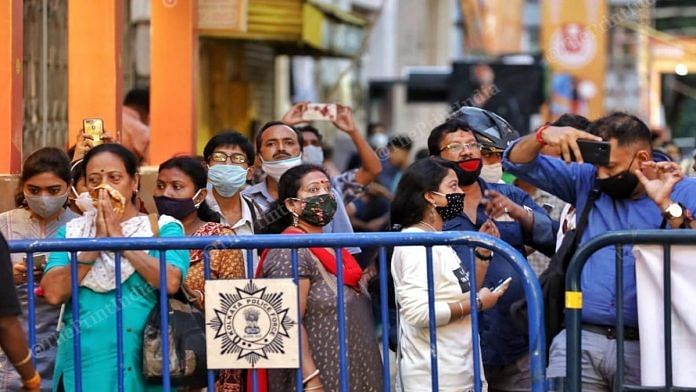New Delhi: Ban on public events can bring down the Covid-19 R value — a key measure of virus transmission — by 24 per cent in less than a month, a peer-reviewed study published in The Lancet has claimed.
The study has been conducted by researchers at the University of Edinburgh. Based on data from 131 countries, the study seeks to assess the effect individual lockdown measures or combinations of steps — including a complete lockdown — have on the R number over a 28-day window after they are introduced or lifted.
The measures studied included ban on gatherings of more than 10 people and public events, school and workplace closures, and stay-at-home orders.
According to the authors of the study, restrictions on public events may be the only lockdown measure that has a statistically significant impact on curbing Covid transmission on its own, that is, without any additional restrictions.
Other non-pharmaceutical interventions — such as school and workplace closures and stay-at-home orders — work best when imposed collectively, the researchers said.
The University of Edinburgh team suggests that the impact of public-event bans can be attributed to the fact that they are likely to prevent super-spreader events, or events where multiple people contract the virus. Over the course of the pandemic, this was often the first measure to be introduced in countries.
The research comes as the UK and many European nations are imposing different degrees of lockdowns in the face of a fresh Covid surge. In India, which imposed a near total lockdown between March and June, most of the restrictions have now been eased. In the latest guidelines, issued on 30 September, the government has allowed public gatherings with over 100 participants outside containment zones, but with certain conditions.
“We found that combining different measures showed the greatest effect on reducing the transmission of Covid-19. As we experience a resurgence of the virus, policymakers will need to consider combinations of measures to reduce the R number,” Harish Nair, a professor at University of Edinburgh, said in a statement released with the study.
“Our study can inform decisions on which measures to introduce or lift, and when to expect to see their effects, but this will also depend on the local context — the R number at any given time, the local healthcare capacity, and the social and economic impact of measures,” he added.
Also Read: India’s R value continues downward trend to settle at 0.90 this week, Delhi goes above 1
How different measures affect R
The R number — or reproduction number — is a key measure of virus transmission.
An R value above 1 indicates a growing outbreak and suggests each patient can infect more than one person. An R value below 1 indicates that the outbreak is under control. The number helps researchers examine how a certain disease will progress while also guiding authorities on how to deal with it.
For their paper, the University of Edinburgh researchers studied daily country-level estimates of R, along with data on the measures each country had in place from 1 January to 20 July.
The analysis included 790 phases of different measures from 131 countries.
While studies have earlier found that measures like school closure, social distancing, and lockdown could reduce R substantially, this is the first piece of research to investigate how relaxing these restrictions affects R, the researchers said.
According to the Edinburgh researchers, the lifting of bans on gatherings of more than ten people and re-opening of schools were found to be most strongly associated with an increase in R. They increased the R value by 25 per cent and 24 per cent after 28 days, respectively, the researchers said.
Lifting bans on public events increased R by 21 per cent, removal of internal movement restrictions by 13 per cent, and removing stay-at-home orders increased R by 11 per cent, they added.
Banning public events reduced R by 24 per cent, while school closures brought it down by 15 per cent, workplace closure by 13 per cent, restrictions on internal movement by 7 per cent, and stay-at-home restrictions by 3 per cent, the study says.
In addition, the researchers used modelling to analyse the impact four combinations of measures could have on tackling the resurgence of SARS-CoV-2, the virus that causes Covid-19.
They found that the least effective package was a ban on public events and gatherings of more than ten people, which could reduce R by 29 per cent in four weeks.
The second package, combining workplace closures with bans on public events and gatherings of more than 10 people, could reduce R by 38 per cent in the same period.
The third package — workplace closure, ban on public events and gatherings of more than 10 people, and internal movement limits — could reduce R by 42 per cent.
The most comprehensive package was a combination of school and workplace closure, ban on public events and gatherings of more than 10 people, internal movement limits, and stay-at-home requirements, which reduced R by 52 per cent.
The team also found that it took an average of eight days after introducing a measure to see 60 per cent of its effect on reducing the R number.
Also Read: Is the R number still useful? It can’t be the sole guide to coronavirus policies



